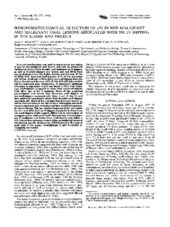Immunohistochemical detection of p53 in non-malignant and malignant oral lesions associated with snuff dipping in the Sudan and Sweden
Ibrahim, Salah Osman; Johannessen, Anne Christine; Idris, Ali M.; Hirsch, Jan M.; Vasstrand, Endre N.; Magnusson, Bengt; Nilsen, Rune
Journal article
Permanent lenke
https://hdl.handle.net/1956/2157Utgivelsesdato
1996Metadata
Vis full innførselSamlinger
Sammendrag
Immunohistochemistry was used to examine the expression of p53 in pre-malignant oral lesions and oral squamous-cell carcinomas (SCCs) from Swedish and Sudanese snuff-dippers, as well as in pre-malignant oral lesions and oral SCCs from non-snuff-dippers from the Sudan, Sweden and Norway. Of the 14 SCCs from Sudanese snuff-dippers, 21% (3/14) expressed p53. Of the 14, 60 and 41 SCCs from non-snuff-dippers from the Sudan, Sweden and Norway, 64% (9/14), 65% (39/60) and 68% (28/41) expressed p53, respectively. A statistically significant difference in expression of p53 was found in SCCs from Sudanese snuff-dippers compared to those from non-snuff-dippers from all/or any of the 3 countries. None of the suspected pre-malignant oral lesions from Sudanese snuff dippers or non-snuff-dippers expressed p53. Only 2 out of the 15 oral fibro-epithelial hyperplastic lesions from Swedish snuff-dippers expressed p53. Some of the oral epithelial dysplastic lesions, as well as the carcinoma in situ lesions from Norwegian non-snuffdippers, expressed p53, while the oral fibro-epithelial hyperplastic lesions did not. The low relative frequency of p53 expression found in oral SCCs from snuff-dippers compared to those from non-snuff-dippers might suggest differences in mechanisms of oncogenic action induced by snuff. Alternatively, the pathogenesis of malignant oral lesions from snuff-dippers may follow a p53-independent pathway. In view of the unusually high levels of the tobacco-specific nitrosamines (TSNA) found in the type of snuff used in the Sudan, investigations of p53 mutations or oncogenes are needed.
